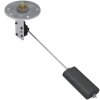Hi Again;
I have a question, my boat have fuel gauge, when the gauge is on reserve but the gauge move a lot, I put gas, I put over 14G the gauge is full but i think that this is a few no?
I bought the boat last year and all is original, gauge included and is all working, do you know any way to see my tank capacity? can it be changed?
Thanks
I have a question, my boat have fuel gauge, when the gauge is on reserve but the gauge move a lot, I put gas, I put over 14G the gauge is full but i think that this is a few no?
I bought the boat last year and all is original, gauge included and is all working, do you know any way to see my tank capacity? can it be changed?
Thanks



